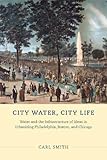City water, city life : water and the infrastructure of ideas in urbanizing Philadelphia, Boston, and Chicago / Carl Smith.
Material type: TextPublisher: Chicago : University of Chicago Press, 2013Description: xii, 327 pages : illustrations ; 24 cmContent type: text Media type: unmediated Carrier type: volumeISBN: 9780226022512; 022602251XSubject(s): Municipal water supply -- United States -- History -- 19th century | Waterworks -- United States -- History -- 19th century | Urbanization -- United States -- History -- 19th century | Municipal water supply | Urbanization | Waterworks | United States | 1800-1899Genre/Form: History.DDC classification: 363.6/1097309034 LOC classification: TD223 | .S64 2013
TextPublisher: Chicago : University of Chicago Press, 2013Description: xii, 327 pages : illustrations ; 24 cmContent type: text Media type: unmediated Carrier type: volumeISBN: 9780226022512; 022602251XSubject(s): Municipal water supply -- United States -- History -- 19th century | Waterworks -- United States -- History -- 19th century | Urbanization -- United States -- History -- 19th century | Municipal water supply | Urbanization | Waterworks | United States | 1800-1899Genre/Form: History.DDC classification: 363.6/1097309034 LOC classification: TD223 | .S64 2013| Item type | Current library | Call number | Copy number | Status | Notes | Date due | Barcode |
|---|---|---|---|---|---|---|---|
 Books
Books
|
Female Library | TD223 .S64 2013 (Browse shelf (Opens below)) | 1 | Available | STACKS | 51952000200529 | |
 Books
Books
|
Main Library | TD223 .S64 2013 (Browse shelf (Opens below)) | 1 | Available | STACKS | 51952000200536 |
Includes bibliographical references (pages 247-312) and index.
Introduction : city water, city life -- The river, the aqueduct, and the lake : bringing water to Philadelphia, Boston, and Chicago -- The individual and the collective : water, urban society, and the public good -- Nature and art : water and the reconciliation of the natural and the urban -- The urban body and the body of the city : the sanitary movement, the temperance crusade, and the water cure -- The flow of time -- Epilogue.
"A city is more than a massing of citizens, a layout of buildings and streets, or an arrangement of political, economic, and social institutions. It is also an infrastructure of ideas that are a support for the beliefs, values, and aspirations of the people who created the city. In City Water, City Life, celebrated historian Carl Smith explores this concept through an insightful examination of the development of the first successful waterworks systems in Philadelphia, Boston, and Chicago between the 1790s and the 1860s. In this period the United States began its rapid transformation from rural to urban. Through an analysis of a broad range of verbal and visual sources, Smith shows how the discussion, design, and use of waterworks reveal how Americans framed their conceptions of urban democracy and how they understood the natural and the built environment, individual health and the well-being of society, and the qualities of time and history. As citizens debated matters of thirst, finance, and health, they also negotiated abstract questions of secular and sacred, real and ideal, immanent and transcendent, practical and moral. By examining the place of water in the nineteenth-century consciousness, Smith illuminates how city dwellers perceived themselves during the great age of American urbanization. But City Water, City Life is more than a history of urbanization. It is also a refreshing meditation on water as a necessity, as a resource for commerce and industry, and as an essential - and central - part of how we define our civilization."--Jacket.
1 2

There are no comments on this title.